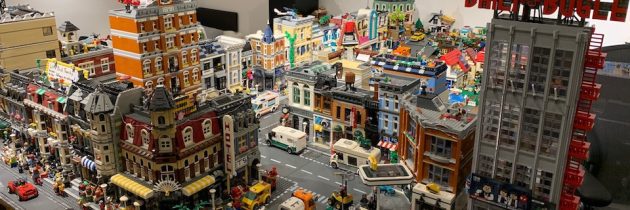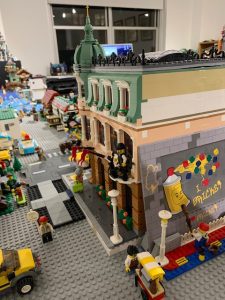Being Selective: Writing and LEGO Building
There are a number of ways in which my profession — writing — and my principal hobby — LEGO building — come together. Right now is one of those moments, as I’m teaching a class on worldbuilding in fiction at the same time as The LEGO Group announced a record number of large sets for adult builders as part of the company’s 90th anniversary.
I had already set my sights on the new roller coaster with two loops and motorizing capability when I watched the virtual LegoCon over the weekend. The event was fast-paced and fun, with appearances by some of my favorite designers. Among the new products announced were two that I added to my “most wanted” list — the enlarged Dr. Strange Sanctum Sanctorum, designed to fit into a modular town, and the 90th anniversary Lion Knights’ Castle, a replica of castles I’ve seen in my travels that also incorporates elements from castles I built with Derrick when he was a child.
But I have a problem! My space and funds are limited. Both the roller coaster and the castle cost $400, and the Sanctum Sanctorum is $250, making it at least $50 more that other Modulars of that size. The roller coaster is just under a meter (39″) tall, with a base that requires a wide, deep, and stable location. Adding a Modular building outside the annual themed building (Boutique Hotel, Police Station, Bookshop, etc.) will fill up my available space that much faster. And where am I going to fit a giant castle? I know Derrick will want it in the future for Jonah and Reed, but they’ll be shoving small objects into their mouth or up their nose for another year or two.
 I have to choose wisely in building my Lego town, something I’ll talk about in my presentation because writers have to do the same in creating the setting of their stories. A novel has limited words, and details of setting share space with characters, dialogue, and action. Even more important, readers have limited attention, and stories that begin with pages of exposition on place, or info dump this with every scene change will bore quickly. The key to evoking a fictional world is to present the key details for a full experience (including sensory details beyond sight) and to make those details do double or triple duty. So along with dropping the reader into the characters’ world, setting details should show the reader what is most important to the point of view character (revealing character), highlight potential points of conflict (revealing theme), and foreshadow later events (revealing plot and structure). One of the examples I’ll use comes from my forthcoming novel Torch. It takes place in the first chapter, when Pavol meets his girlfriend Lída the day before his fateful trip to Prague:
I have to choose wisely in building my Lego town, something I’ll talk about in my presentation because writers have to do the same in creating the setting of their stories. A novel has limited words, and details of setting share space with characters, dialogue, and action. Even more important, readers have limited attention, and stories that begin with pages of exposition on place, or info dump this with every scene change will bore quickly. The key to evoking a fictional world is to present the key details for a full experience (including sensory details beyond sight) and to make those details do double or triple duty. So along with dropping the reader into the characters’ world, setting details should show the reader what is most important to the point of view character (revealing character), highlight potential points of conflict (revealing theme), and foreshadow later events (revealing plot and structure). One of the examples I’ll use comes from my forthcoming novel Torch. It takes place in the first chapter, when Pavol meets his girlfriend Lída the day before his fateful trip to Prague:
Now was an overcast Thursday, three days after he, Tomáš, and Štepán had finished the letter. The morning was unseasonably warm but with a chill in the air that signaled a coming cold snap. In front of the old church in Rozcestí’s main square — turned into an auditorium for Party events — Pavol squeezed Lída’s hand.
I could have described every building in the main square — I’d already created a map and labeled them — but from Pavol’s perspective, the building that matters most is the former church. Pavol’s family, from Slovakia, is devoutly Catholic and has endured repression and poverty as a result, though we also learn over time that the 17-year-old has a complicated relationship with his faith. Still, the idea of the church turned into a site of Community Party propaganda events is foundational to his support of the Prague Spring liberalization and his despair at the Soviet invasion and occupation of his country.
Just as my description of the square from Pavol’s eyes does double duty in revealing his background and mood, my decision of which building to add to Little Brick Township will depend on its double duty. Right now, I’m leaning toward the Sanctum Sanctorum, not because I love the exterior or interior of the building. I modified the Daily Bugle skyscraper, leaving out all the Marvel characters and scenes and replacing them with my own. I won’t be adding the comic-book characters to this one either, but when I placed the Boutique Hotel on the baseplate leading to my original Skate Park, I had room for one more building along with an alleyway in front of the Skate Park where skateboarders could gather. It turns out that the Sanctum Sanctorum features its own alleyway — and on the correct side (though if it weren’t I could have reversed the directions). I’ve also checked my parts drawers, and I can substitute a different color — dark red instead of nougat — for the upper-floor facade since I also have the profile bricks for several other colors.
However, I stare wistfully at the listings of the sets I will not be buying. They’re my Lego equivalent of killing darlings — description, scenes, and characters that must be cut because they don’t fit, they slow the pacing, or they’re out of character. But as not buying a set now doesn’t mean not buying it ever (unless it’s retired), those bits that never made it into the manuscript or were cut in revision may find a new home in your next project!







